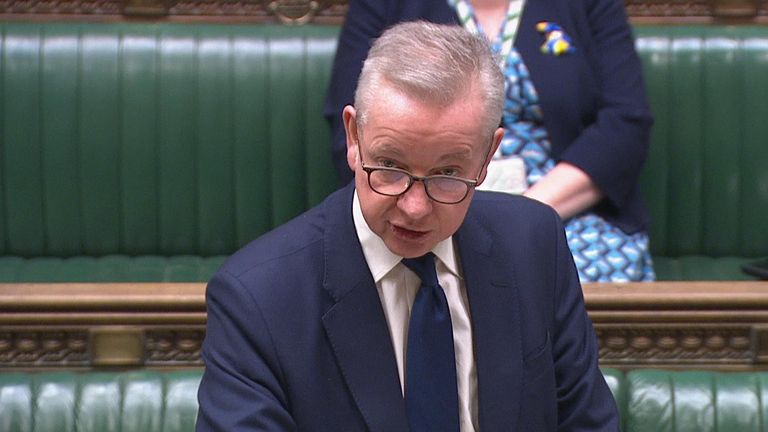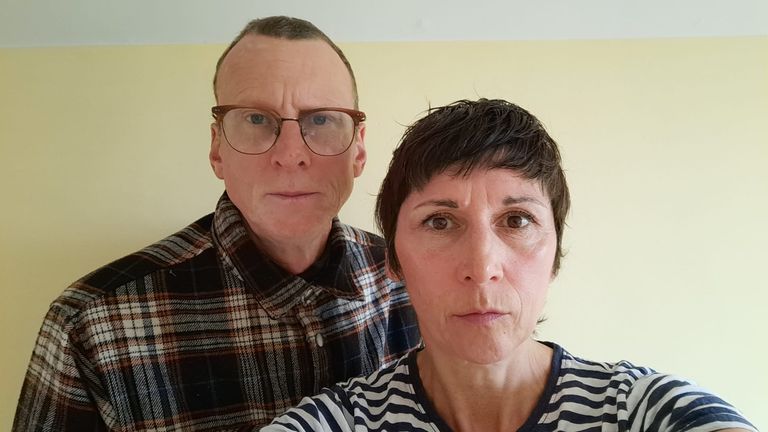Cladding crisis: ‘No end in sight’ for flat owners still trapped in unsellable homes despite major repair scheme


Flat owners caught up in the cladding crisis say they will remain trapped in unsellable homes despite a major new scheme to help fund repairs.
The long-awaited Cladding Safety Scheme (CSS) opened this week and will provide £5bn to fix medium-rise tower blocks with flammable external walls in cases where the developer cannot be traced.
It has been billed by the government as the “biggest intervention on building safety to date” and aims to protect leaseholders from the expensive costs of remediating their properties that have emerged since the Grenfell Tower disaster.
Politics latest: Boost for Sadiq Khan as councils fail with ULEZ legal challenge
But Lisa Petty, who is facing a £21,000 bill, told Sky News the announcement will “have absolutely no bearing on my situation”.
The 42-year-old lives in a building in Romford, Essex, with the same type of ACM cladding blamed on the rapid spread of the deadly fire at Grenfell Tower in 2017, which killed 72 people.
Because the building is less than 11 metres in height, it does not qualify for government funding.
Lisa said: “It’s so frustrating to hear the government say all leaseholders are blameless when they have left out a whole group of us living in buildings below 11 metres.
“The government is contradicting itself because they say if you’re under 11 metres that’s a lower risk to life so you don’t need remediation, but at the same time they have acknowledged there’s a risk because they have banned ACM cladding on (new) buildings irrespective of height.”
Advertisement
Read more:
The post-Grenfell cladding scandal has left me penniless and about to go bankrupt’
Grenfell Tower six years on: ‘Frustration over lack of change is turning to anger’
While ministers have repeatedly insisted buildings below this threshold are safe and remediation work is not necessary, government guidance contains no restriction on repairs being required.
Officials from the Department of Levelling Up, Communities and Housing (DLUCH) have intervened over Lisa’s case, but fire engineers are standing firm in their position the works are needed in order for the building to meet safety standards.
The long-running saga resulted in the sale of Lisa’s flat collapsing and her mortgage payments rising by £450 a month – as she switched to a variable rate when she thought she would be moving.
Lisa said the problems have limited “every aspect of my life” and it feels like there’s “no end in sight”.
“I can’t begin to quantify the impact it’s had, it’s exhausting,” she said.
“I want children and I’ve thought about adoption in the past, but that’s not something I feel like I can pursue because my future and my financial stability is so dependent on this situation.
“It just feels like your life isn’t your own and you are just worried to spend any money.
“I shouldn’t be made to pay to make this building safe that I had absolutely no say in designing or signing off.”
‘Buildings will only be made half safe’
Since the Grenfell Tower fire killed 72 people in 2017, the cladding scandal has trapped thousands of flat owners in unsafe and unsellable homes – with many facing huge repair bills to fix them.
The opening of the CSS means that costs of fixing dangerous cladding for all buildings in England over 11 metres will now be covered either by government funding or by companies who built them.
Please use Chrome browser for a more accessible video player

1:09
Housing developers have been told by Michael Gove to commit to repairing unsafe buildings or be banned from the market.
The DLUCH said the scheme will give “tens of thousands of residents across England a pathway to a safe home”.
But the End our Cladding Scandal (EOCS) campaign group said while welcome “there are still many hundreds of thousands of people trapped in the building safety scandal, including those in buildings under 11 metres in height”.
They added the scheme will only make buildings “half safe” because it does not cover historic non-cladding fire safety issues, like internal defects and missing cavity barriers.
The government has introduced a £10-£15k legal cap on what can be charged to fix these widespread problems, but this excludes certain leaseholders, including landlords of more than three flats.
‘We are being punished’
Patsy Sweeney, who owns three small rentals in Birmingham with her husband, feels like she is being “punished” for investing into property to self-fund her retirement.
The former insurance broker said she was “accidentally” pushed into the “non-qualifying” threshold because she had wanted to sell the flat she was living in and move to a house during the pandemic – but the cladding issues made that impossible.
“I was going round the bend, getting really desperate to get out of the flat and feeling trapped, so we took a view to rent it out and get a mortgage for the house and (months later) that was what put us over the threshold.”
The 56-year-old now faces “uncapped financially liability” for the non-cladding issues, which she fears will cost tens of thousands of pounds.

“I can’t see any logic to it. You could have two flats that are worth £2m in some parts of London and be qualified, or you could have three in the north of England for £300,000 and be unqualified, so it seems really punitive.
“Whether I have one flat or 10 I didn’t make these buildings, so it’s irrelevant.”
Labour has urged the government to “rethink” the cap exclusion, arguing it will expose non-qualifying leaseholders to financially ruinous bills and delay remediation in the cases where they simply can’t pay.
Shadow housing minister Matthew Pennycook told Sky News: “The millions of people whose lives are on hold as a result of the building safety crisis need the government to grip and drive the national remediation effort that is required to make all buildings safe and to reconsider their damaging decision to abandon a minority of leaseholders to extortionate non-cladding remediation costs.”
‘Human cash machines’
The government has not set a timeline for when homes should be remediated under the CSS, but said thousands of buildings will benefit “over the next decade”.
For Patsy, this casts a dark shadow over her plans for a comfortable retirement.
Her future costs are unknown, but she calculates the cladding crisis has already cost her £1m in rising building insurance, service charges, mortgage rates, extra stamp duty and landlord licensing fees.
She fears she will never see the equity from the flats as the “non-qualifying” status stays with the property’s lease after it’s sold so even if the issues are fixed, “no one will ever want to buy them”.
Patsy said: “I’m not a wealthy individual. Some people might think I am because I’ve got these properties but all we did was use our savings to look after our future for when we retired and now that money is being spent on a problem caused by developers.
“We are being treated like human cash machines that took a commercial risk and are now being told to live with the consequences. How is that right?”